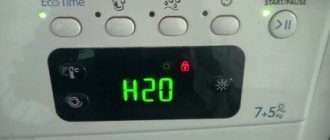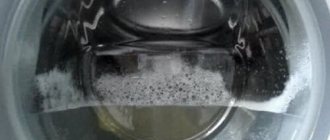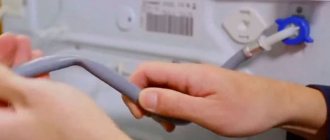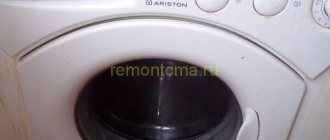By “does not wash,” users of washing machines may mean completely different problems. Here are the main ones:
- the machine fills with water, but then the drum does not rotate;
- water enters the tank, then the washing machine drains the water and stops, perhaps an error appears on the display;
- SMA pours water and turns off.
Let's figure out the reasons for this strange behavior of the washing machine.
The washing machine takes in water, but does not wash: reasons
The problem may occur as a result of improper transportation, poor-quality connection and violation of operating conditions.
The list of popular factors also includes:
- belt jumping off the drum pulley;
- drum blocking;
- jamming of bearings in the tank;
- motor failure;
- control module failure;
- heating element burnout.
If your machine draws water correctly and does not wash at all, its hose may be damaged.
Important! Difficulties in collecting water also arise due to clogged sewers.
Belt problem
Breakage occurs as a result of heavy load on the drum when washing a large amount of laundry. If you regularly exceed the loading rate, the drum axis weakens, the element becomes unbalanced and wears out.
Replacing the drive belt
Drum blocked
Large objects can get into the space between the tank and the drum. They prevent rotation during the washing process. If you pull them out, the device will work again.
Belt and direct drum drive
Bearing failure
The parts ensure the rotation of the drum. When the washing machine quickly fills with water, rattles, knocks, but does not wash at all, the destruction of the bearings has begun. If you do not pay attention to the failure in time, there is a risk of belt breakage and drum damage.
Replacing washing machine drum bearings
Engine malfunction
The motor of an automatic machine does not completely fail - only its brushes wear out. For models with an asynchronous motor, failure occurs as a result of loss of capacitance of the starting capacitor. In this case, the engine does not gain speed at all. Brushes and capacitors need to be replaced, and the motor needs to be rewound.
Control module burned out
This problem can only be identified by disassembling the equipment. It looks like black marks on components or board tracks. Repairs should only be carried out at a service center. Otherwise, the machine may break down completely.
The module can only be repaired at a service center
The heating element burned out
When a modern washing machine does not wash at all after a high-quality supply of water, the heating element may break down. After downloading, the temperature sensor does not send commands to heat up and start the engine. The second reason for heating element failures is the formation of scale on it.
The heating element may break due to scale on it
Breakdown of the pressure switch
The water level sensor sends a command to draw water and determines the fill level of the tank. The resulting sediment, scale, and small debris lead to malfunctions. A constant supply of water becomes a consequence of clogging or air leakage.
Incorrect operation of the intake valve
The part is responsible for collecting and supplying water. If the valve fails, it cannot shut off the water. When the membrane is weakened, liquid is pumped in even when the washing machine is turned off.
Impeller clogs
If buttons, rivets, coins, threads or hair get in the way, the impeller turns with difficulty or does not rotate at all. The node must be cleared of debris.
The cause of the breakdown may be the impeller
Electrical wiring breakdowns
If the automatic washing machine draws running water well and then suddenly stops, the reason is overheating of the parts. Similar failures can be caused by faulty wiring or a short circuit in the network.
Excessive drain hose length
The standard length of the water drain pipe is 150 cm. A long length eliminates the ability of the pump to pump water and it is simply not enough for the washing cycle.
Important! A malfunction may occur when moving the automatic machine and extending the hose.
Software glitches
Some washing machine models do not have automatic spinning. When you collect water and there is no work, you need to manually set the spin cycle.
Clogged pipes
Small objects may get into the pipes. After removing the blockage yourself or calling a technician, the equipment will start working.
Other causes of the problem
Good water intake and lack of start can occur due to:
- severe pinching or kinking of the drain hose;
- poor fixation of the drain system;
- constant supply of water to the tank due to a broken valve;
- incorrect connection to communications;
- air access to the pump.
Attention! The minimum height of the hose for correct operation of the equipment is 50 cm.
Inlet valve failure
If the inlet valve in the washing machine has stopped functioning correctly, this may also be the reason why the device constantly fills with cold water. If the valve has lost its technical characteristics, then water will continuously flow into the washing machine
In this case, it doesn’t even matter whether the machine is on or off
The fill valve is needed to allow a certain amount of water to enter the machine. When the machine is connected to the network and the program is started, a magnetic field appears, which helps tighten the rod and open the membrane. Then the water penetrates into the hopper of the powder dispenser, and then into the tank of the machine. When the required amount of liquid is collected, no electricity is supplied to the coil and the water stops flowing.
Water inlet valve location
If the inlet valve of the washing machine breaks down, water constantly fills into the tank. This problem can be resolved as follows. If the machine is equipped with a horizontal loading type, you should remove the top cover, under which the valve is located. For a machine with a vertical loading type, it is located at the bottom, so you will have to remove the side panel.
It is not difficult to dismantle the old valve and install a new one; the main thing is to select a part that is identical to the one being replaced when purchasing. After removing the cover behind which the valve is located, you should disconnect the wires and hoses attached to the clamps from it. Some manufacturers attach hoses to disposable clamps, so when purchasing an inlet valve, it is better to immediately purchase clamps. Next, unscrew the valve itself or bend the latches, after which it is turned and removed. Installation is carried out in strictly reverse order.
The washing machine draws water, but does not wash: self-diagnosis
If water build-up and problems with drum rotation are detected, self-repair is not recommended. The user can only perform diagnostics.
Emergency water drain
After disconnecting the equipment from the network:
- Unclench the fasteners on the back of the housing and disconnect the pipe from the sewer drain;
- Place the hose in a bucket to drain the water;
- Place a container under the hatch and unscrew the plug.
Emergency drain diagram
Important! Modern automatic machines have a special valve for emergency draining.
Tank and Drum Inspection
The device is disconnected from the network, after which:
- The side panels are removed;
- The drum is checked - it needs to be turned a little;
- Debris or foreign objects between the tank and drum are removed.
If there is no blockage and the drum does not spin, contact a technician.
Seized bearings
The part is just being replaced. Without skills and equipment, self-repair is contraindicated.
Cleaning filters
The machine needs to be turned off. Further actions:
- Removing the front hatch, under which the filter is located;
- Rinsing the clogged element with running water.
The filter needs to be cleaned regularly
Advice! When unscrewing the filter, water will flow from the hose, so place a basin under it.
Checking the drive belt
The part must remain in place. If it is not on the pulley, install it with the calculation of 1 clove per 1 pulley. The torn belt is replaced by a technician.
Removing blockages from the pipe
To check the drain hose:
- Unscrew the fasteners on the drain;
- Remove and inspect the hose, feel it with your fingers;
- Carefully remove debris with a long wire or knitting needle.
After cleaning, the hose is reinstalled.
Calling a master: where to find and how much to pay?
If it is impossible to carry out diagnostics and repairs yourself, you must call a specialist. It is better to search for a company that repairs household appliances on the Internet.
The companies' websites have contact information and prices. You can read reviews about companies on the Internet. Firms that have been operating in the market for a long time are fighting for their reputation.
The cost of work depends on the company’s pricing policy and the complexity of the breakdown.
Average prices are:
changing the drive belt – from 900 rubles;- replacement of motor brushes – from 1,400 rubles;
- replacement of tachometer – from 2,100 rubles;
- engine replacement or repair – from 2,000 rubles;
- repair of the control unit – from 2,000 rubles;
- replacement of heating elements - from 1,400 rubles;
- repair of the pressure switch - from 1,600 rubles;
- replacement of a temperature sensor – from 1,300 rubles, etc.
It should be borne in mind that the cost of work does not include the price of new parts if replacement is required. If a new part that needs to be installed instead of a worn one is already in stock, this must be reported to the dispatcher accepting the order.
Contacting random repairmen whose phone numbers were found through an ad may result in poor-quality repairs. In addition, there is a chance of falling for scammers who will carry out the work negligently. After the repair work is carried out, the company representative gives a guarantee .
A lot of important and useful information about repairing Indesit washing machines is presented in this section.
Incorrect connection
If the machine constantly takes in water and then drains, the reason for the incorrect operation is the incorrect installation of the connecting hose. The flexible hose for pumping out liquid should not touch the floor; the farthest bending point is located at a height of 500-600 mm from the floor covering. To hold the hose, standard plastic clamps are used on the back wall of the case; if the bracket is broken, then it is necessary to install a loop (for example, from a plastic clamp for electrical wiring).
To check the correct operation of the drain you need to:
- Start the work cycle without loading laundry.
- Wait until the tank is filled with water.
- Activate liquid drain mode.
- Stop pumping water by pausing.
- Visually check the change in fluid level through the glass hatch. If water continues to flow out, then additional adjustments to the position of the drain hose are necessary. If the liquid level does not drop, then you should continue to search for the reason for the constant operation of the pump. The technique is not used on top-loading machines due to the lack of a glass hatch.
The sealing of the water level control in the tank is broken
Depressurization of the water system is one of several malfunctions.
- Leaky tank. If the container is not made of solid stainless steel, but is only sprayed (anodized) with chromium-nickel additives, over time it is mechanically erased, a layer of ordinary rusting steel is exposed, and the tank begins to leak in a matter of days. Sealing a tank is a questionable procedure. The tank is replaced at a service center for the repair of washing machines and dishwashers.
- Faulty level sensor. Breakage of the housing will lead to leakage.
- Leaky drum cuff. This is an O-ring that prevents water from leaking out of the hatch at the front of the machine. Leaky or perforated rubber from which it is made is a source of leakage. It makes sense to seal it if you know how to vulcanize tubes, tires and hoses. This is done using a piece of raw rubber and a heated soldering iron, sealant and several other means that reliably eliminate the hole (or gap). In other cases, the cuff is changed.
- Damaged corrugations, hoses that form the water circuit both inside and outside the machine. If a long hose cannot be shortened at the leak site without compromising the proper water supply, then it is replaced with a new one.
- Broken pipes of the intake and exhaust water valves. They are made of plastic that is resistant to fractures even with strong impacts, but over the years they also fail. Replace the entire valves.
- A holey or cracked powder tray. Water is supplied to the tray section to wash away and dissolve the powder and descaler in the washing water collected in the tank. Holes and crevices in the tray will lead to leakage. In some SMA models, the tray can be removed completely (it is a pull-out shelf with rounded sides at the edges or a tray) - it must be replaced. There is no excess pressure on it, except perhaps from the jet gushing from the inlet pump, but poor repair of the leak will lead to its rapid and repeated failure.
How to understand what is broken
Before you begin repairs, you need to figure out what is causing the problem. If you cannot verify that the machine is connected correctly, perform the following test:
- Start a regular wash program without laundry.
- When the machine is full, press the “drain” button.
- After this, use the “pause” button to stop the process.
The mechanism should stop draining. If you still hear the sounds of liquid escaping into the pipes, then your device is not connected correctly.
To detect the siphon effect, in the evening or morning, when many people are using the sewer along the riser, open the faucet in the sink. If at some point you notice that it began to be drawn into the pipes with squelching sounds, most likely there is a small blockage in the pipes. If you cannot eliminate it, you will have to install a siphon filter. It will maintain the correct current.
In all other cases, we are talking about defects in parts, which we will discuss below.
Recommendations:
- When installing the device, do not forget about the laws of physics - if the height of the drain hose is less than 0.5 m, water will accumulate and drain immediately.
- For hard water, use special softeners or install a magnetic converter.
- To prevent the device from being damaged by voltage surges, install a protective relay.
- After the wash cycle, do not use the appliance immediately, let it rest and cool down.
- To avoid damage, clean the device filter once every two months.
- Once every six months you can carry out preventive descaling. To do this, you should use only certified products suitable for your machine model.
- Use detergents designed for automatic washing.
Errors related to the ECU board
The memory chips located on the control unit board contain all service algorithms and washing programs. If a failure occurs, the memory must be removed from the ECU (unsoldered or removed from the microcircuit connectors) and reprogrammed with a special device - a programmer.
If the connection between the display module and the ECU board is broken, this malfunction of the Indesit washing machine manifests itself in the lack of response to buttons and the inability to execute programs. If after disconnecting from the 220 V network and rebooting the ACM nothing has changed, check the condition of the connectors and the reliability of the switching connections. The most likely fault is in the display module board or ECU.
Faulty electric motor
Another reason for problems with washing may be a breakdown of the electric motor. Main faults:
- The brushes in the electric motor are worn out.
- The starting capacitor located in the asynchronous electric motor has failed.
Experts note that the engine may not turn on due to prolonged washing, for example, a series of loads lasting more than 1.5 hours. To change the brushes you need to:
- Unscrew the bolts and remove the engine.
- Disconnect the sensors and belt.
- Unscrew the terminal from the brush using a screwdriver.
- Unscrew the bolts and remove the carbon electrode or do this by releasing the spring. If the removed electrode is shorter than one and a half centimeters, it must be replaced.
- When removing the brush, it is necessary to note in which direction the ends of the coal are ground, because if they are placed with the opposite side, the motor may spark.
Very important: it is necessary to replace two brushes at once; it is not recommended to change one at a time. Next, you need to clean the commutator from scratches and coal dust: you need to use fine sandpaper, which you need to apply to the commutator and rotate the shaft. Rotations must be continued until the collector is cleaned.
After these manipulations, it is necessary to install the engine in place, connect all the elements and test the unit.
In the article, we looked at possible reasons why the washing machine fills with water, but does not wash. Now you know how to deal with these problems yourself.
The control unit has failed
If you notice that the device does not wash clothes in the allotted time, that is, the washing mode increases several times, and at the same time the tank is filled for half an hour, then the rinsing process is delayed, a failure has occurred in the control module, which controls all processes in the device.
This breakdown occurs in Indesit and Hansa machines. Usually the control unit is carefully protected from any deformation, but in the event of a power surge or natural wear and tear, it fails. Manufacturers do not recommend opening it, cleaning contacts or performing unqualified repairs. It would be more correct to install a new part of the same brand, otherwise a software conflict will arise.
Whatever problem occurs with your equipment, the service technicians will help you deal with it. We work any time from 7:00 to 23:00. Call us at number.
Prevention
There are certain preventive measures to help prevent possible failure of the Indesit washing machine. By observing simple safety measures, you can significantly extend the life of your equipment and ensure its long, uninterrupted operation. Among the useful recommendations for owners of equipment of this brand, the following can be highlighted.
- Routine maintenance after each wash. It consists of wiping the hatch cuff, cleaning the filter, and cleaning the powder cuvette. It is also recommended to regularly clean the washing machine body from powder, fingerprints, grease and other contaminants.
- Ventilation through the hatch. A simple but effective rule is to always leave the washing machine door open at the end of the wash cycle. This will allow the moisture remaining inside to evaporate and prevent the appearance of fungus, mold, and bacterial plaque inside the equipment body.
- Cleaning the drain filter. It is located on the front or back panel of the washing machine, closed with a special shield or door, depending on the model. Regular cleaning of the drain filter ensures that a specific unpleasant odor does not appear inside the equipment. To perform the work, this part is unscrewed, accumulated debris is manually removed, and the plastic base is washed under running water. After complete cleaning, the part can be installed in its original place.
- Regular cleaning of the system. In modern models of washing machines, there is a “Self-cleaning” mode for this purpose, similar to what is used when starting up the equipment. The unit starts up without laundry, and a cleaning agent is placed in the powder compartment. The duration of such a wash ranges from 45 to 70 minutes. It is recommended to carry out a preventative launch once every 6 months or after 40-50 times of using the equipment in normal mode.
- Water softening. For this purpose, a special filter is used, installed in the pipeline between the inlet hose of the machine and the water supply system. When passing through the components placed in the flask, the water becomes less hard; with systematic use, this allows you to avoid damage to the internal parts of the equipment due to calcified deposits.
- Once every 3 years, it is recommended to carry out a complete preventive maintenance of the washing machine with complete dismantling and checking the degree of wear of parts. As part of the service, in this case, the pipes, engine, pump, and other mechanical parts are inspected. This approach allows you to promptly identify wear of parts and replace them without waiting for emergency situations to occur.
READ MORE: How to adjust washing machine feet |
| -it-yourself repairs By following these recommendations, every owner of an Indesit washing machine can ensure long-term and comfortable operation without failures, errors and breakdowns.
To learn how to determine the error code in Indesit washing machines, see the following video.
Changing the heating element
If the heating element breaks down and the Indesit washing machine stops heating the water, you need to replace the heating element.
Steps:
- First, determine the location of the part. To do this, you can use the instructions with a description for your model. But if you don’t have it at hand, you can limit yourself to inspection. If there is a large back cover, the heating element is probably hidden under it, and it is this that needs to be removed.
- If the part is on the front, install the back cover back and remove the front wall.
Possible causes and solutions
| Probable Cause | Photo | How to check | How to fix |
| No flow or low pressure from the water supply | When you open the taps of the water supply system, water does not flow or flows weakly | Turn off the machine and wait for the problems in the plumbing system to be resolved | |
| Clogged inlet hose or inlet strainer | Disconnect the supply hose and filter, inspect them and blow them out | Clean the hose and filter from debris and rinse under running water. | |
| The side door is not closed tightly, the lock does not work | Check the tightness of the door, the condition of the locking mechanism and the fastening of the door hinges | Press the door firmly until the lock clicks. If necessary, clean the latching mechanism and tighten the hinges | |
| Damage to connecting wires or their insulation, oxidation of contacts | Inspect and test the internal electrical wiring with a tester for open circuits and short circuits. | Restore the integrity of electrical wires and their insulation, clean contacts | |
| The inlet (fill) valve does not work | Check the operation of the valve when 220V is applied to it. Inspect and test the valve windings, electrical wires and contacts with a tester | Restore the connecting wires, clean the contacts. Replace the faulty valve. | |
| The electric door lock is faulty | Test the blocker winding with a tester for open circuit and short circuit. Check the status of contacts | Clean contacts. Replace the faulty lock. | |
| The level sensor (pressure switch) is faulty | Check if the sensor receiving tube is clogged. Test the sensor and connecting wires with a tester for opens and short circuits. | Clear the sensor receiving tube of any accumulated debris. Replace faulty sensor. | |
| The software control module is faulty | The module does not receive control signals to trigger the machine components when they are working properly | Use a tester to check the receipt of control signals to individual nodes. Repair the module in a workshop or replace it with a working one. |
Most of these problems can be fixed on your own, but in some cases you cannot do without contacting a service workshop.
If you decide to carry out the repairs yourself, we offer the best range of spare parts for washing machines.
View all valves »
View all hatch locks »
View all pressure switches »
View all control modules »











